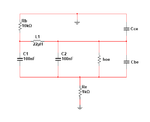Follow along with the video below to see how to install our site as a web app on your home screen.
Note: This feature may not be available in some browsers.
Another gremlin may be that the inductor has a core material that has a non linear BH curve, such that different levels of ac excitation can shift the inductance, even if there is no change in net dc.
Strictly speaking at the frequency that fulfills the Barkhausen oscillation condition. That's not necessarily the frequency of maximum loop gain. The phase condition has to be met, too.Its interesting, that oscillation will occur where the overall gain plus phase produces maximal feedback around the loop.
In my calculation it's 1/(2*pi*√(22uH*50nF)) = 151.7 kHz, quite near to observed frequency...

The circuit looks good. Apparently you didn't calculate it's resonance frequency correctly. I presume Cbe, Cce << 100 nF, also transistor input impedance is large against Xc, so the resonator capacitance is effectively a series circuit of two 100 nF capacitors.This it's the equivalent circuit that I made
No, it does not.The circuit looks good.